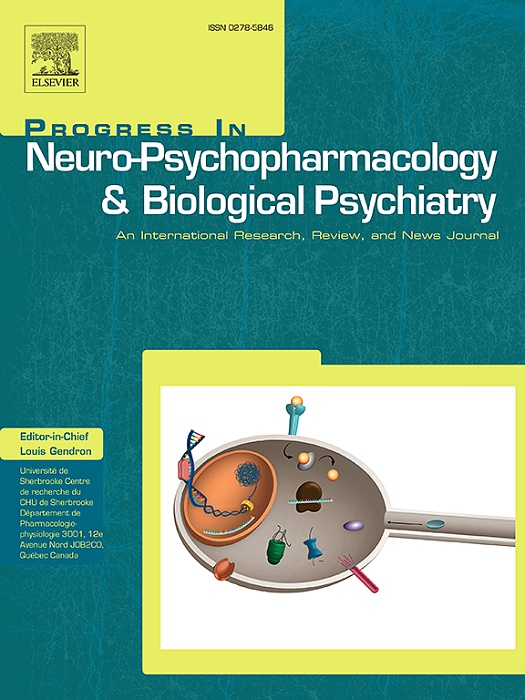精神分裂症谱系中不同类型妄想的结构和功能改变:系统综述。
IF 5.3
2区 医学
Q1 CLINICAL NEUROLOGY
Progress in Neuro-Psychopharmacology & Biological Psychiatry
Pub Date : 2024-10-30
DOI:10.1016/j.pnpbp.2024.111185
引用次数: 0
摘要
背景:尽管妄想作为一种跨病理的精神病理现象在临床上发挥着重要作用,但针对精神分裂症谱系中不同类型妄想的实验研究数量仍然相对较少,其结果也不尽一致。我们旨在了解目前有关妄想中大脑结构和功能改变的知识状况,以确定特定类型的妄想是否与特定的大脑改变有关,并找出妄想形成和持续的共同改变,无论其内容如何:在本系统性综述中,我们遵循PRISMA指南,在PubMed上搜索1953年至2023年9月30日期间发表的英文论文。筛选的初始纳入标准是使用 fMRI、sMRI 或/和 dwMRI 方法研究精神分裂症谱系障碍中的妄想或亚临床妄想信念、精神分裂症高临床风险或遗传风险的文章。筛选阶段的排除标准是研究病变诱发或药物诱发妄想、阿尔茨海默病和其他神经认知障碍的妄想、单个病例研究和非人类研究的文章。出版物元数据已上传至系统综述工作网络工具 Rayyan。每项研究的详细信息都填写在表格中:结果:我们找到了 1752 条记录,其中 95 份全文文献经过审阅后被纳入本文。非特异性妄想和特殊类型妄想都与广泛的结构和功能改变有关。在所有妄想类型中,受影响最明显的区域是颞上皮层(主要是左侧语言处理区)、前扣带回/内侧前额叶皮层和岛叶。妄想症中最易重复的发现可能是杏仁核功能的改变及其与其他区域的相互作用。躯体妄想症和妄想侵袭症的主要特征是脑岛和丘脑的改变:数据模棱两可,但总的来说,预测处理框架似乎是解释不同类型妄想的最广为接受的方法。在处理社会信息、自我产生的信息和感觉信息时,异常的预测错误可能导致对他人意图的评估不准确、模糊刺激的自我相关性、对自我产生的行为和异常感觉的错误归因,从而引发相应的具有迫害性、参照性、控制性和躯体性内容的妄想。然而,现有的数据还不足以对妄想症预测编码的具体生物机制得出结论。因此,还需要进一步的研究来探索更多的同质群体以及妄想类型与诊断之间的相互作用。本综述还存在一些局限性。研究病变、药物滥用或神经变性诱发妄想的研究,以及使用 fMRI、sMRI 或 dwMRI 以外模式的研究均未纳入综述。由于文献数量相对较少,我们根据妄想的特定类型对其进行了系统化处理,而结果也可能受到患者诊断、是否接受治疗、治疗类型、病程长短等因素的影响。本文章由计算机程序翻译,如有差异,请以英文原文为准。
Structural and functional alterations in different types of delusions across schizophrenia spectrum: A systematic review
Background
Despite the high clinical role of delusions as a transnosological psychopathological phenomenon, the number of experimental studies on the different types of delusions across schizophrenia spectrum is still relatively small, and their results are somehow inconsistent. We aimed to understand the current state of knowledge regarding the structural and functional brain alterations in delusions to determine whether particular types of delusions are associated with specific brain changes and to identify common alterations underlying the formation and persistence of delusions regardless of their content.
Methods
For this systematic review, we followed PRISMA guidelines to search in PubMed for English papers published between 1953 and September 30, 2023. The initial inclusion criteria for screening purposes were articles that investigated delusions or subclinical delusional beliefs in schizophrenia spectrum disorders, high clinical or genetic risk for schizophrenia using fMRI, sMRI or/and dwMRI methods. Exclusion criteria during the screening phase were articles that investigated lesion-induced or substance-induced delusions, delusions in Alzheimer's disease and other neurocognitive disorders, single case studies and non-human studies. The publication metadata were uploaded to the web-tool for working on systematic reviews, Rayyan. For each of the studies, a table was filled out with detailed information.
Results
We found 1752 records, of which 95 full-text documents were reviewed and included in the current paper. Both nonspecific and particular types of delusions were associated with widespread structural and functional alterations. The most prominent areas affected across all types of delusions were the superior temporal cortex (predominantly left language processing areas), anterior cingulate/medial prefrontal cortex and insula. The most reproducible findings in paranoia may be alterations in the functioning of the amygdala and its interactions with other regions. Somatic delusions and delusional infestation were mostly characterized by alterations in the insula and thalamus.
Discussion
The data are ambiguous; however, in general the predictive processing framework seems to be the most widely accepted approach to explaining different types of delusions. Aberrant prediction errors signaling during processing of social, self-generated and sensory information may lead to inaccuracies in assessing the intentions of others, self-relevancy of ambiguous stimuli, misattribution of self-generated actions and unusual sensations, which could provoke delusional ideation with persecutory, reference, control and somatic content correspondingly. However, currently available data are still insufficient to draw conclusions about the specific biological mechanisms of predictive coding account of delusions. Thus, further studies exploring more homogeneous groups and interaction of diagnoses by types of delusions are needed. There are also some limitations in this review. Studies that investigate delusions induced by lesions, substance abuse or neurodegeneration and studies using modalities other than fMRI, sMRI or dwMRI were not included in the review. Due to the relatively small number of publications, we systematized them based on a certain type of delusions, while the results could also be affected by the diagnosis of patients, the presence and type of therapy, illness duration etc.
求助全文
通过发布文献求助,成功后即可免费获取论文全文。
去求助
来源期刊
CiteScore
12.00
自引率
1.80%
发文量
153
审稿时长
56 days
期刊介绍:
Progress in Neuro-Psychopharmacology & Biological Psychiatry is an international and multidisciplinary journal which aims to ensure the rapid publication of authoritative reviews and research papers dealing with experimental and clinical aspects of neuro-psychopharmacology and biological psychiatry. Issues of the journal are regularly devoted wholly in or in part to a topical subject.
Progress in Neuro-Psychopharmacology & Biological Psychiatry does not publish work on the actions of biological extracts unless the pharmacological active molecular substrate and/or specific receptor binding properties of the extract compounds are elucidated.

 求助内容:
求助内容: 应助结果提醒方式:
应助结果提醒方式:


